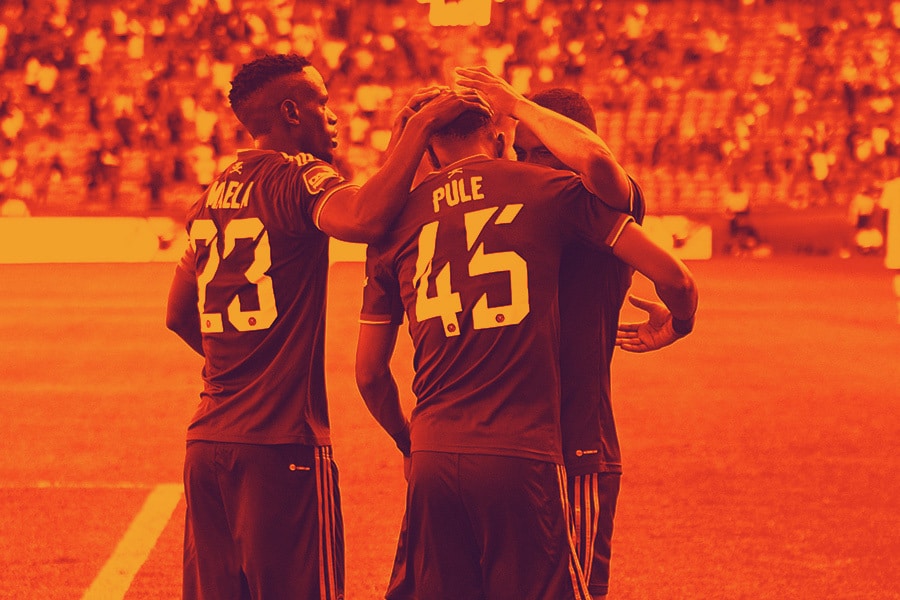
The general consensus after Pirates’ MTN8 triumph was that we finally had a genuine challenger for the title. A league table since Pirates beat Sundowns 3-0 in the MTN8 that victory would put Pirates in 14th, with one win, and three points. Currently, 5th on the actual table, some of the underlying numbers suggest that perhaps this is where they rightfully belong. They may have conceded six goals in the last four matches, but those goals have come against four of the league’s five best-attacking teams in Chiefs, Sundowns, Cape Town City & Arrows (in xG terms).
Overall, they are good at preventing quality shots from the opposition, with their 0.88 xG conceded per game the second-best in the top flight. Combine this with an xG per shot conceded of just 0.1 (3rd best in the league) and you can safely say they are one of the league’s best at suppressing shots.
Earlier in the season, they were comfortably the best on all defensive counts, so even if they are still impressive, there is a marginal decline. One can conclude that they’ve quickly gone from a great defence to being just a good one. And when your attack is also misfiring, it can be a recipe for some poor results.
The 10-game rolling xG timeline shows this deadly combination of slight defensive fall-off (red line going up) and decline in attacking output (green line going down). We previously made a case in this article that Pirates’ defensive solidity had come at the expense of their attack, and how that could work for a short Cup run, not for a title challenge. You need goals in the title race. Their 1.14 xG per game is slightly below the league average (1.2), and their shot volume is fairly mediocre (11 per game, level with Sekhukhune & Sekhukhune).
What’s Happening In The Second Half?
The spotlight has recently moved from their defence to their attack, mainly because of their second-half scoring troubles. Until this past weekend, Pirates were the only team yet to score a goal in the second half this season, but nothing really stands out when you look at some of the possession metrics before and after the break. They are in the opposition third as often in the first half as the second, averaging 18 such touches every 15 minutes.
Box touches are also similar (9-10), although the one thing that stands out is that they have more shots in the second half than the first. While this could be a result of desperation, it is worth looking a bit more into. Pirates’ first-half shot locations are on the left, while second-half shots are on the right. They seem to be more efficient in the first half than the second, with a 6% drop off in shooting efficiency between the two periods. It may seem small, but the margins are fine in top-level football.
Do Pirates Have A Decision Making Problem?
Pirates shot volumes and quality may be average, but the one thing they excel in is entrances into the opposition box. Only Sundowns (19 per game) have a better ratio than Pirates this season (17), while the league average is only 14.
In the recent loss against City, they managed 20 entries into the box (their second most since the Spaniard came to town), and maybe a significant part of the goalscoring record is their decision-making when they make their way there. A low xG per 90 may be a symptom of poor decision-making/shot choice, where players shoot from unlikely angles when there are better options. There were a few instances in this game.
As early as the second minute, Saleng finds himself in a promising position but chooses to go for goal. The shot was decent and forced the save, but a switch in play may have opened up better alternatives.
As early as the second minute, Saleng finds himself in a promising position but chooses to go for goal. The shot was decent and forced the save, but a switch in play may have opened up better alternatives.
On the half-hour, the layoff to Erasmus was on, or a switch wide, but once again, a tame shot from an unlikely scoring distance was taken, not troubling the keeper. These are shots that are scored once in fifty attempts, whose xG was given as 0.02.
This was the common theme of Pirates’ display, and it didn’t stop. Late in the game, Pule takes a similar ambitious effort from both an unlikely angle and distance. When these go in, they can win Goal of the Season, but you can’t rely on worldies to win games on a weekly basis.
It’s clear that the majority of attacks come from the wide attackers coming in centrally to create problems. Unsurprisingly, Monnapule Saleng stands out as their main attacking threat, with Deon Hotto joint-second on the shot-takers list. Their main shot-takers rely on long-distance shots, with Saleng often taking aim outside the box. Hotto also leads the team for key passes this season, with Saleng right behind. These outlets are responsible for creating chances and are also taking the most shots (instead of finishers or target men), and these shots are often taken in suboptimal positions. Last season, Kwame Peprah led the team for shots.
Another example of the decision-making problem from the City game. Hotto was the main threat, constantly free to receive forward passes. Below, Thamsanqa Mkhize is so far up the pitch when the counter attack begins, and the space left behind made Timm’s decision to play the pass to Hotto easy. (The same pair would later combine for the goal, although higher up the pitch and not on a counter).
But the way this promising attack fizzled out was symbolic of the poor decision-making on the day (and maybe all season). Hotto waits until he is in the box to make the pass, and even when he does, he hits it long to no-one. By the time Erasmus went back to salvage the attack, City had regrouped.
At a tactical level, Pirates were excellent in the first half against City. But on a decision-making level, they were disappointing, with their delayed actions and poor shot choices preventing them from building a healthy lead. Second-half goals won’t really matter if you’re 2-0 or 3-0 up at half-time. In fact, the narrative will quickly switch to “Pirates are so efficient, they kill you off in the first half”. But as long as that weird second-half stat continues, the questions will too. Riveiro’s problem, though, remains to convert any possession superiority into chances and goals.
























